Steel tubes it is difficult to repair under pressure, but a plumbing clamp with a rubber seal will help save the situation. A simple device can be bought or made by hand. And it is better to get a plumbing clamp in advance - at a critical moment there will be no time to think about it.
The content of the article:
-
Types of clamps with rubber seals
- Pipe clamp
- Reinforced plumbing clamp
- Clamp Rubber
- Repair couplings
- Large diameter plumbing clamps
- Why is a clamp with a rubber seal convenient?
- How to choose a clamp
Types of clamps with rubber seals
In everyday life and home appliances, a huge number of different types of clamps are used. Most often these are models with a tape or wire base, tightened using a built-in worm, a wrench, or just a bolt-nut pair.
With their help, hoses are attached to washing machines, electrical cables are fixed, and flexible connections are crimped. By design, such parts are similar to each other, differ only in the width of the clamp and the fixing element. But they are not suitable for plumbing work.
A real plumbing clamp differs from its "brothers" in a number of ways:
Wide clamping surface.
Crimping is performed evenly over the entire surface of the pipe.
A special type of rubber seal is used.
Clamping on plumbing fixtures is performed using a nut-bolt pair. Only in this case can it provide reliable fixation on the pipe surface.
Any other worm-screw, self-tapping, spring-loaded or self-tightening type clamps do not provide constant force. This means that it is technically possible to clamp the clamp with the seal to the required amount of force, but over time, release will occur, and the seal will weaken.
The second important element is the rubber seal. Conventional fasteners can use hot stamped black rubber. For repair work, such a seal can only be used as a compensating rubber band between the clamp band and the pipe surface. At the same time, there should be no leakage of water or the presence of condensation at the attachment point, otherwise at the point of contact of the metal with the gasket, the metal or the clamp itself will eventually rot from corrosion.
The repair clamps use an EPDM seal.
Let's look at the main types of clamps for plumbing pipes and determine the most popular ones.
Pipe clamp
More often, a model consisting of two halves is taken for a plumbing clamp. The structure consists of two half-arcs made of profiled steel strip with a galvanized coating.
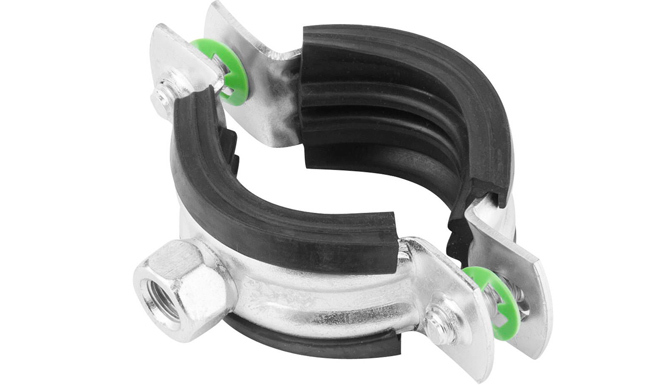
A rubber seal with a profiled inner surface is placed inside the ring.
The pipe clamp is mainly used as a support bracket for fixing pipes at a certain distance from walls or floors. Therefore, on one of the halves there is a welded nut for installing a support from a threaded rod or bolt.
The clamps can be made on the basis of a bolt-nut pair or in the form of a pair of self-tapping screws for metal.
Bolt Clamps can be used as plumbing or repair clamps. In this case, the standard seal is replaced with an EPDM rubber gasket, or the damaged area is additionally wound with a thin sanitary rubber tape.
On sale you can find yellow clips without a rubber seal. These are seal rings used on gas pipes. They cannot be used for repair work.

Reinforced plumbing clamp
One of the problems of using repair devices is considered to be high pressure in the pipe being repaired. In domestic water supply and steam heating mains, the pressure with temperature can reach 30 atm and 120 ° C, respectively.
Therefore, for repair work at joints or damaged places, they use models in the form of a loop, bent from a thick strip of stainless steel.
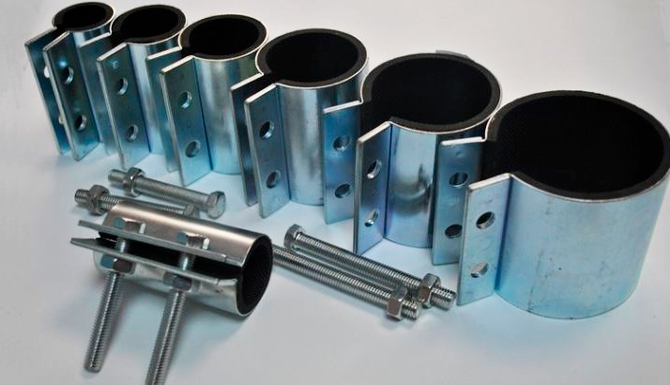
To open the flaps, the hinge has to be pre-wedged with a wooden insert. The rubber seal is put on the pipe separately. After the device is put on it, the wooden wedge is knocked out, a rubber gasket is put inside and the bolts are tightened.
To block fistulas on high-pressure water pipelines, one-piece double-loop clamps can be used as plumbing clamps. The quality of the clamp is high, but such a device can only be put on through the end or cut of the pipe.
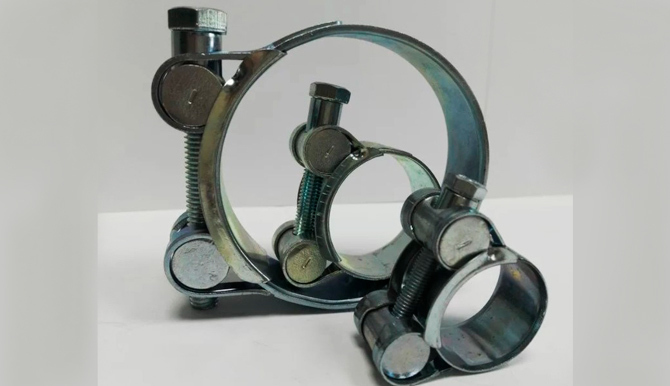
Clamp Rubber
One of the simplest and cheapest options. It is a stamped steel strip, 15 mm wide. Basically, it is a steel hinge with two bolt holes, on which a rubber seal is placed.

A Rubber clamp is used for plumbing repair of small diameter pipes, from 8 mm to 50 mm.
In addition to blocking the damaged area, the Rubber device can be used to crimp hoses on pipes, reinforcement of previously installed but damaged clamps, fixing pipes to walls and load-bearing surfaces.
The only drawback is that when choosing a Rubber system, you need to correctly select the loop diameter. It must exactly match the pipe diameter, excluding the rubber seal.
Repair couplings
They are used as a reinforcing band on high pressure pipes with signs of corrosion, deep damage to the metal. The usual repair option is not suitable, even when using a self-adhesive rubber seal.
Deep double-sided corrosion of the metal means that the pipe can fail at any time. Therefore, in such a situation, a simple crimp with a rubber seal does not give the desired result.
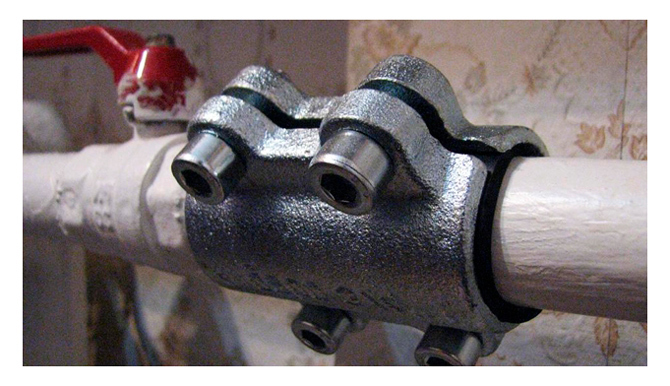
The situation can be corrected by using a repair sleeve consisting of two identical halves.
There is already a thread inside the holes, so the plumbing work to repair the fistula turns out to be simple:
- The surface of the metal is cleaned, treated with a compound that stops corrosion.
- A rubber seal is screwed onto the pipe.
- The halves of the coupling are connected and bolted together.
The plumbing clamp has the same disadvantage as the Rubber device. The pipe diameter must be 2-3 mm less than the fitting size of the coupling, otherwise the rubber seal will not block the damaged area. Unit sizes start at 25mm diameter for half-inch pipes.
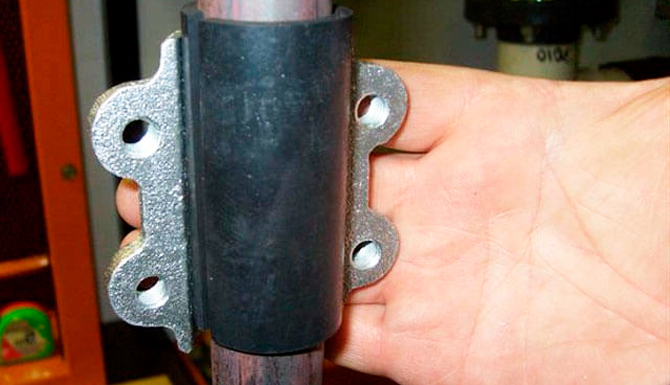
Large diameter plumbing clamps
For pipes from 100 mm to 160 mm, blocking bands and clamps made of thin sheet steel with a clamp based on threaded rods and nuts are used. Plumbing clamps for repairs are made in the form of a one and a half loop with welded shelves for clamping.
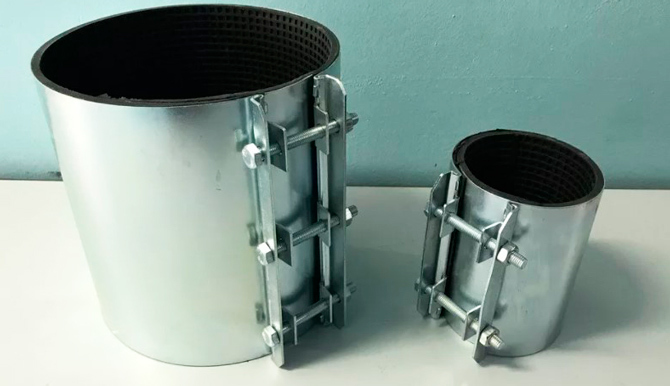
In this case, a standard rubber seal is hot applied to the inner surface of the steel strip. Alternatively, an annular insert is used.
Before installing the bandage, the damaged surface is treated with polyurethane paint or sealant, which ensures stable operation of the rubber seal even under conditions of temperature difference or alternating mechanical stress.
Plumbing clamps can be installed on free-flow lines of large diameter without a rubber seal. It is enough to blow out the pipe surface around the damaged area with polyurethane foam and put on the clamp. Self-expanding polyurethane foam will fill all cavities and securely fix the repair pad. It is no longer necessary to tighten the fasteners after the foam has hardened.
Large diameter steel clamps can be used to make diversion, and without relieving the water pressure in the line.

For polypropylene and polyethylene lines with a diameter of 1.5-2 inches, it is easier to make a tapping using a plumbing saddle clamp.
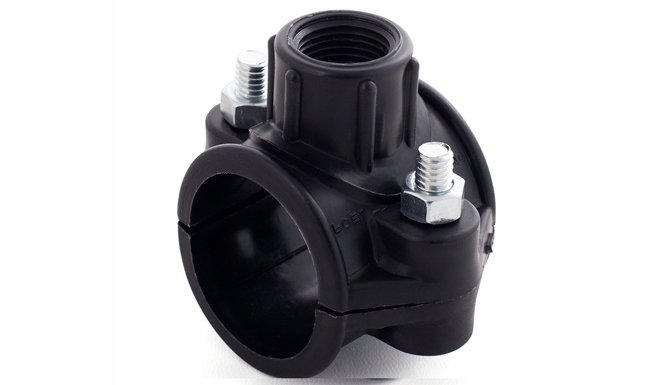
Rating of the most commonly used types of clamps:
Pipe clamp
1
Reinforced plumbing clamp
1
Non-separable branch clamps
1
Repair couplings
1
Yellow clips without rubber seal
-1
Clamp Rubber
-1
Large diameter plumbing clamps
-1
Saddle clamp
-1
Why is a clamp with a rubber seal convenient?
The use of a protective bandage in the form of a clamp tie is allowed only for straight sections without sockets and turns. The pressed rubber seal must adhere evenly to the surface to be repaired. Otherwise, it will not be possible to achieve a reliable fixation of the bandage. This is the only drawback.
The usability of the device includes:
Reusability of use. The steel strip patch with quality rubber seal can be used an unlimited number of times.
Quick installation - the band can be mounted on a leak without relieving pressure in the pipe.
The ability to adjust the force of pressing the rubber seal to the damaged area.
Installation of the patch does not require special preparation of the band or pipe surface. The repair device can be in the damaged area indefinitely. After installation, you need to additionally tighten the fastener once to compensate for the permanent deformation of the seal.
How to choose a clamp
The choice of the repair band model directly depends on the pressure in the pipe and the place of installation. For high-pressure lines, repair couplings with four tightening points must be used. Any other models, even with a high-quality rubber seal, do not ensure the tightness of the band.

For domestic plumbing work, it is best to have two-half bandages or a Rubber loop in stock. For a small diameter water supply system, products made of mild galvanized steel can be used. For lines greater than one inch in diameter, stainless steel bands are used.
A plumbing clamp with a rubber seal can be considered a universal repair tool. The design turned out to be so successful that the bandages can stand on heating or water supply for several years before major repairs. The device is easy to make yourself.
How to put a clamp on a heating register: video
Have you ever made custom-design plumbing clamps? Share a description and experience of using homemade bandages. Does it make sense to make a bandage with your own hands if you can buy it? Save the article to bookmarks, share it on social networks.


